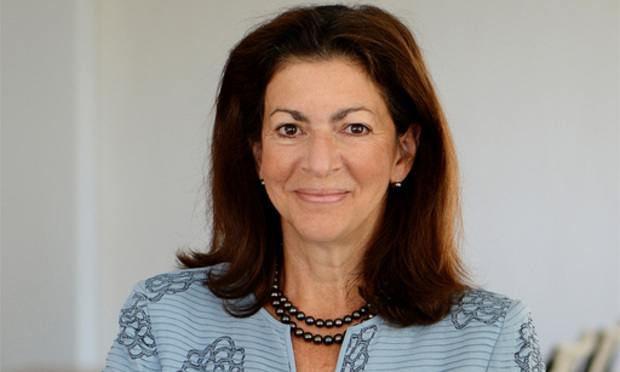Innovation, client crossover or just a growth play - what would a Bryan Cave merger bring to BLP?
What does the proposed Bryan Cave tie-up offer for BLP, beyond a 'merge until you're mega' strategy?
October 19, 2017 at 06:30 AM
6 minute read
Bryan Cave's firmwide strategic plan, released in 2015, included a core pillar of innovation.
At internal meetings, the US firm stressed the importance of a more than 30-strong team of technologists, pricing professionals and project managers that have helped it twice win the Innovative Firm of the Year award from the International Legal Technology Association (ILTA).
In Berwin Leighton Paisner (BLP), Bryan Cave appears to have found a transatlantic partner that has proven it can change the law firm business model and has won a slew of its own industry innovation awards.
In 2007, former BLP partner Simon Harper launched Lawyers on Demand (LOD), the flexible lawyering business that inspired a rash of imitators. It now has more than 600 lawyers on its books and operates as a "separate BLP group company". While some US firms have changed their staffing models on certain projects, none have a business that would compare with LOD.
As BLP and Bryan Cave leaders seek to sell the proposed combination to their partners in the coming weeks, they are likely to emphasise that like-minded view of innovation, as well as practice groups and clients that overlap in real estate, litigation and corporate.
The firms have said they will not comment on the merger until a vote occurs at a to-be-determined date. Still, if the thinking of two former Bryan Cave partners is any indication, those in favour of the deal will have to overcome scepticism that the creation of a 1,500-lawyer global firm is simply a growth play.
"This 'merge until you're mega' (strategy) will only ever work for a handful of firms," said one individual, who requested anonymity in order to speak freely about internal matters. "And Bryan Cave is considerably down the list of candidates for which that play could pan out."
There is some indication that the structure of a combined firm would be its own small slice of law firm business model innovation.
While most international firms are structured with split profit pools, often as Swiss vereins, the release announcing the BLP-Bryan Cave merger discussions states that a united firm would be one of only a handful operating in a "one-firm" structure. Many believe law firms with a single profit pool create better incentives for lawyers to share clients across geographic regions, something stressed by Bryan Cave and BLP in their announcement.
On the shared clients front, BLP lists American International Group (AIG) as a client. Bryan Cave, which is led by chair Therese Pritchard (pictured above), has a long history with AIG dating back to at least 2005, when former partner James Cole was appointed to oversee activities at the insurance giant as part of a deferred prosecution agreement with federal authorities. Bryan Cave and Cole, now a leader of Sidley Austin's white-collar group, reportedly received $20m in fees from that long-running assignment.
If a B+ firm merges with a B+ firm, it's still a B+ firm
Bryan Cave's London office lists 37 lawyers who mostly handle corporate matters, ranging from a banking practice to private wealth services. BLP's private wealth planning group is highly rated, but the firm's largest and best-known practice is undeniably its real estate group, which accounts for more than a third of the firm's lawyers.
A significant presence in Europe and the UK would potentially help Bryan Cave's lawyers serve their domestic client base abroad. The firm's roots are in St Louis, Missouri, where many of its large clients are headquartered, including agribusiness giant Monsanto, beverage behemoth Anheuser-Busch InBev, electric utility Emerson Electric and batteries manufacturer Energizer Holdings.
"Bryan Cave has decades of experience representing clients on a global basis," said Aaron Williams, a St Louis-based legal recruiter. "I see this potential merger as a positive for both firms and their clients. I do not see any downside to the merger, just a strengthening of service and lawyer quality."
However, one former partner said he was sceptical that a merger with BLP would help the firm to be seen as higher quality.
"Firms like Bryan Cave have a tendency to always merge with equals. So they tend to always get bigger and bigger," the former partner said. "If a B-plus firm merges with a B-plus firm, it's still a B-plus firm. The size doesn't make it any better; it just gets bigger."
Both Bryan Cave and BLP have seen merger discussions with other firms run aground in recent years. Bryan Cave's talks with now-defunct Dickstein Shapiro ended in late 2015, as the bulk of the latter struck a deal with Blank Rome.
BLP and Greenberg Traurig held tie-up talks about a year and a half ago. The failure of that merger was partially attributed to different pay structures at each firm, with Greenberg operating under a 'black box' model and BLP using a modified lockstep structure.
A Bryan Cave partner described the firm's compensation system as "very subjective", taking into account a number of types of credit. It also involves the firm's practice economics group, which considers clients' profitability and the total growth of a relationship, the partner said.
On the financial side, the firms have broadly similar profits per partner, with BLP posting PEP of £630,000 for 2016-17 and Bryan Cave having a similar figure of $865,000 (£650,000) for 2016.
On the innovation front, Bryan Cave's technology push was largely started by former partner John Alber, who briefly left the firm in the 1980s to start and then sell a tech-based logistics firm. Alber helped structure the firm's innovation initiative into a series of working groups that are focused on technology, the economics of law practice and an alternative staffing model.
Since Alber retired more than a year ago, Kathryn DeBord has served as chief innovation officer, a role that last year saw her help launch a consulting service called BCXponent to help streamline law departments. The firm in 2011 won its first ILTA innovation award for its three-pronged approach to innovation. Bryan Cave won the top award again in 2014 for its Rosetta software, which converts lawyers' financial metrics into a narrative designed to help them practise more efficiently.
One source said Bryan Cave's business would be better served by boosting its "head start" in innovation rather than growing via merger.
"Perhaps even move in the other direction on scale – becoming smaller and more focused, and achieving efficiency by technical sophistication rather than mere numbers," the source said. "That's the real opportunity for a firm as creative as Bryan Cave."
That will ultimately be up for the firm's partners to decide.
NOT FOR REPRINT
© 2025 ALM Global, LLC, All Rights Reserved. Request academic re-use from www.copyright.com. All other uses, submit a request to [email protected]. For more information visit Asset & Logo Licensing.
You Might Like
View All

A&O Shearman Exits Continue as New York Partner Joins Cleary

Clyde & Co Launches Office in Texas Through Combination With Dallas Insurance Boutique
2 minute readTrending Stories
- 1'It's Not Going to Be Pretty': PayPal, Capital One Face Novel Class Actions Over 'Poaching' Commissions Owed Influencers
- 211th Circuit Rejects Trump's Emergency Request as DOJ Prepares to Release Special Counsel's Final Report
- 3Supreme Court Takes Up Challenge to ACA Task Force
- 4'Tragedy of Unspeakable Proportions:' Could Edison, DWP, Face Lawsuits Over LA Wildfires?
- 5Meta Pulls Plug on DEI Programs
Who Got The Work
Michael G. Bongiorno, Andrew Scott Dulberg and Elizabeth E. Driscoll from Wilmer Cutler Pickering Hale and Dorr have stepped in to represent Symbotic Inc., an A.I.-enabled technology platform that focuses on increasing supply chain efficiency, and other defendants in a pending shareholder derivative lawsuit. The case, filed Oct. 2 in Massachusetts District Court by the Brown Law Firm on behalf of Stephen Austen, accuses certain officers and directors of misleading investors in regard to Symbotic's potential for margin growth by failing to disclose that the company was not equipped to timely deploy its systems or manage expenses through project delays. The case, assigned to U.S. District Judge Nathaniel M. Gorton, is 1:24-cv-12522, Austen v. Cohen et al.
Who Got The Work
Edmund Polubinski and Marie Killmond of Davis Polk & Wardwell have entered appearances for data platform software development company MongoDB and other defendants in a pending shareholder derivative lawsuit. The action, filed Oct. 7 in New York Southern District Court by the Brown Law Firm, accuses the company's directors and/or officers of falsely expressing confidence in the company’s restructuring of its sales incentive plan and downplaying the severity of decreases in its upfront commitments. The case is 1:24-cv-07594, Roy v. Ittycheria et al.
Who Got The Work
Amy O. Bruchs and Kurt F. Ellison of Michael Best & Friedrich have entered appearances for Epic Systems Corp. in a pending employment discrimination lawsuit. The suit was filed Sept. 7 in Wisconsin Western District Court by Levine Eisberner LLC and Siri & Glimstad on behalf of a project manager who claims that he was wrongfully terminated after applying for a religious exemption to the defendant's COVID-19 vaccine mandate. The case, assigned to U.S. Magistrate Judge Anita Marie Boor, is 3:24-cv-00630, Secker, Nathan v. Epic Systems Corporation.
Who Got The Work
David X. Sullivan, Thomas J. Finn and Gregory A. Hall from McCarter & English have entered appearances for Sunrun Installation Services in a pending civil rights lawsuit. The complaint was filed Sept. 4 in Connecticut District Court by attorney Robert M. Berke on behalf of former employee George Edward Steins, who was arrested and charged with employing an unregistered home improvement salesperson. The complaint alleges that had Sunrun informed the Connecticut Department of Consumer Protection that the plaintiff's employment had ended in 2017 and that he no longer held Sunrun's home improvement contractor license, he would not have been hit with charges, which were dismissed in May 2024. The case, assigned to U.S. District Judge Jeffrey A. Meyer, is 3:24-cv-01423, Steins v. Sunrun, Inc. et al.
Who Got The Work
Greenberg Traurig shareholder Joshua L. Raskin has entered an appearance for boohoo.com UK Ltd. in a pending patent infringement lawsuit. The suit, filed Sept. 3 in Texas Eastern District Court by Rozier Hardt McDonough on behalf of Alto Dynamics, asserts five patents related to an online shopping platform. The case, assigned to U.S. District Judge Rodney Gilstrap, is 2:24-cv-00719, Alto Dynamics, LLC v. boohoo.com UK Limited.
Featured Firms
Law Offices of Gary Martin Hays & Associates, P.C.
(470) 294-1674
Law Offices of Mark E. Salomone
(857) 444-6468
Smith & Hassler
(713) 739-1250










